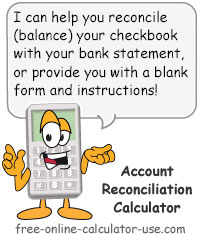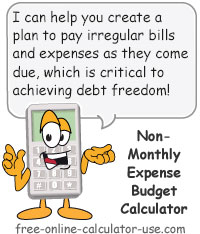IMPORTANT: Numeric entry fields must not contain dollar signs, percent signs, commas, spaces, etc. (only digits 0-9 and decimal points are allowed).
Click the Terms tab above for a more detailed description of each entry.
Step #1:
Enter the ending balance from your checkbook register.
Step #2:
Enter the ending balance from your bank statement.
Step #3:
Enter any and all deposits that appear in your check register but not on your bank statement.
Step #4:
Enter any and all withdrawals that appear in your check register but not on your bank statement.
Step #5:
Tap or click the "Reconcile Bank Account" button. This will display the adjusted statement balance and the amount your checkbook is out of balance with the bank statement.
Step #6:
If you would like to print out the completed bank reconciliation statement, select "Completed" from the Report type line and tap or click the "Reconcile Bank Account" button. This will open the report in a new window for printing.




Follow me on any of the social media sites below and be among the first to get a sneak peek at the newest and coolest calculators that are being added or updated each month.